A Design of Partial Textured Surface on Gear Washers for Reducing Friction and Wear under Low Speed and Heavy Load Conditions
Abstract
:1. Introduction
2. Mixed Lubrication Model
3. Theoretical Predictions
3.1. Parameters Preassigned
3.2. Types of Texture Arrays
3.3. Influence of Distributional Parameters
3.4. Determination of Distributional Parameters
4. Experimental Verification
4.1. Tribological Experimental Tests
4.2. Results and Discussions
5. Conclusions
- An annular gear washer partially covered by surface textures yields lower friction coefficients than its bare counterpart;
- Textures with a sector angle of 20°, texture coverage angle of 12°, circumferential number of 8, and radial number of 6 are selected as the final surface texture distribution arrangement;
- A washer with the obtained texture arrangement exhibits preferable tribological performance and moves its Stribeck curve towards the lower left, implying significant hydrodynamic pressure effect under low rotational speed.
- Comparing with the bare washer, the obtained texture arrangement can reduce weight loss caused by wear.
Author Contributions
Funding
Institutional Review Board Statement
Informed Consent Statement
Data Availability Statement
Conflicts of Interest
References
- Yuan, W.; Dong, G.; Guo, Q.; Sui, W.; Zhang, L.; Yuan, W. Tribological performance of differential gear end-face sliding on washer with a radial groove. Eng. Fail. Anal. 2018, 85, 126–136. [Google Scholar] [CrossRef]
- Zhang, H.; Hua, M.; Dong, G.N.; Zhang, D.Y.; Chin, K.S. A mixed lubrication model for studying tribological behaviors of surface texturing. Tribol. Int. 2015, 93, 583–592. [Google Scholar] [CrossRef]
- Gropper, D.; Wang, L.; Harvey, T.J. Hydrodynamic lubrication of textured surfaces: A review of modeling techniques and key findings. Tribol. Int. 2016, 94, 509–529. [Google Scholar] [CrossRef] [Green Version]
- Zhang, H.; Zhang, D.Y.; Hua, M.; Dong, G.N.; Chin, K.-S. A Study on the Tribological Behavior of Surface Texturing on Babbitt Alloy under Mixed or Starved Lubrication. Tribol. Lett. 2014, 56, 305–315. [Google Scholar] [CrossRef]
- Yousfi, M.; Mezghani, S.; Demirci, I.; El Mansori, M. Mutual Effect of Groove Size and Anisotropy of Cylinder Liner Honed Textures on Engine Performances. Adv. Mater. Res. 2014, 966–967, 175–183. [Google Scholar] [CrossRef] [Green Version]
- Zhao, S.; Wang, X.L. The effects of surface texture on the wear properties of mechanical seals made of metal and polymers. Tribology 2015, 35, 761–767. [Google Scholar]
- Zhang, H.; Qin, L.; Hua, M.; Dong, G.; Chin, K. A tribological study of the petaloid surface texturing for Co–Cr–Mo alloy artificial joints. Appl. Surf. Sci. 2015, 332, 557–564. [Google Scholar] [CrossRef]
- Qin, L.; Lin, P.; Zhang, Y.; Dong, G.; Zeng, Q. Influence of surface wettability on the tribological properties of laser textured Co–Cr–Mo alloy in aqueous bovine serum albumin solution. Appl. Surf. Sci. 2013, 268, 79–86. [Google Scholar] [CrossRef]
- Shen, G.; Zhang, J.; Melentiev, R.; Fang, F. Study on tribological performance of groove-textured bioimplants. J. Mech. Behav. Biomed. Mater. 2021, 119, 104514. [Google Scholar] [CrossRef]
- Chang, T.; Guo, Z.; Yuan, C. Study on influence of Koch snowflake surface texture on tribological performance for marine water-lubricated bearings. Tribol. Int. 2019, 129, 29–37. [Google Scholar] [CrossRef]
- Yan, D.; Qu, N.; Li, H.; Wang, X. Significance of Dimple Parameters on the Friction of Sliding Surfaces Investigated by Orthogonal Experiments. Tribol. Trans. 2010, 53, 703–712. [Google Scholar] [CrossRef]
- Yu, H.; Huang, W.; Wang, X. Dimple patterns design for different circumstances. Lubr. Sci. 2011, 25, 67–78. [Google Scholar] [CrossRef]
- Etsion, I. State of the Art in Laser Surface Texturing. J. Tribol. 2005, 127, 248–253. [Google Scholar] [CrossRef]
- Etsion, I.; Halperin, G.; Ryk, G. Improving Tribological Performance of Mechanical Components by Laser Surface Texturing. Tribol. Lett. 2004, 17, 733–737. [Google Scholar] [CrossRef]
- Hua, M.; Ma, H.; Li, J.; Mok, C.K.A. Tribological behaviours of patterned PVD TiN spot coatings on M2 steel coated with different bias voltages. Surf. Coat. Technol. 2006, 200, 3612–3625. [Google Scholar] [CrossRef]
- Hua, M.; Dong, G.-N.; Zhang, H.; Ho, J.K.L.; Chow, F.-C. The wet tribological behaviors of doughnut patterns laser-textured on DF2 tool steel under different loading conditions. Appl. Phys. A 2013, 111, 997–1011. [Google Scholar] [CrossRef]
- Zhan, J.; Yang, M. Investigation on Dimples Distribution Angle in Laser Texturing of Cylinder–Piston Ring System. Tribol. Trans. 2012, 55, 693–697. [Google Scholar] [CrossRef]
- Lu, Y.S.; Liu, H.P. Design and Fabrication of the Lubricating Dimple of the Headface Sliding Bearing with Phyllotactic Pattern. Adv. Mater. Res. 2013, 658, 367–371. [Google Scholar] [CrossRef]
- Zhang, H.; Liu, Y.; Hafezi, M.; Hua, M.; Dong, G.-N. A distribution design for circular concave textures on sectorial thrust bearing pads. Tribol. Int. 2019, 149, 105733. [Google Scholar] [CrossRef]
- Xie, X.; Hua, X.; Li, J.; Cao, X.; Tian, Z.; Peng, R.; Yin, B.; Zhang, P. Synergistic effect of micro-textures and MoS2 on the tribological properties of PTFE film against GCr15 bearing steel. J. Mech. Sci. Technol. 2021, 35, 2151–2160. [Google Scholar] [CrossRef]
- Zhang, H.; Liu, Y.; Hua, M.; Zhang, D.-Y.; Qin, L.; Dong, G.-N. An optimization research on the coverage of micro-textures arranged on bearing sliders. Tribol. Int. 2018, 128, 231–239. [Google Scholar] [CrossRef]
- Zhang, H.; Liu, Y.; Li, B.; Hua, M.; Dong, G. Improving processing quality and tribological behavior of laser surface textures using oil layer method. Tribol. Int. 2020, 150, 106353. [Google Scholar] [CrossRef]
- Zhang, H.; Dong, G.; Hua, M.; Guo, F.; Chin, K.-S. Parametric design of surface textures on journal bearing. Ind. Lubr. Tribol. 2015, 67, 359–369. [Google Scholar] [CrossRef]
- Marian, V.G.; Kilian, M.; Scholz, W. Theoretical and experimental analysis of a partially textured thrust bearing with square dimples. Proc. Inst. Mech. Eng. Part J. Eng. Tribol. 2007, 221, 771–778. [Google Scholar] [CrossRef]
- Rahmani, R.; Rahnejat, H. Enhanced performance of optimised partially textured load bearing surfaces. Tribol. Int. 2018, 117, 272–282. [Google Scholar] [CrossRef] [Green Version]
- Liu, S.; Chen, W.W.; Hua, D.Y. Hydrodynamic Pressure of Thrust Step Bearings. In Proceedings of the ASME/STLE 2009 International Joint Tribology Conference, Memphis, TN, USA, 19–21 October 2009. [Google Scholar]
- Henry, Y.; Bouyer, J.; Fillon, M. An experimental analysis of the hydrodynamic contribution of textured thrust bearings during steady-state operation: A comparison with the untextured parallel surface configuration. Proc. Inst. Mech. Eng. Part J. Eng. Tribol. 2014, 229, 362–375. [Google Scholar] [CrossRef]
- Patir, N.; Cheng, H. An average flow model for determining effects of three-dimensional roughness on partial hydrodynamic lubrication. J. Lubr. Technol. 1978, 100, 12–17. [Google Scholar] [CrossRef]
- Wu, C.; Zheng, L. An average reynolds equation for partial film lubrication with a contact factor. J. Tribol. 1989, 111, 188–191. [Google Scholar] [CrossRef]
- Tripp, J.H.; Greenwood, J.A. The contact of two nominally flat rough surfaces. Proc. Inst. Mech. Eng. 1970, 185, 625–633. [Google Scholar]
- Hu, Y.; Cheng, H.S.; Arai, T.; Kobayashi, Y.; Aoyama, S. Numerical Simulation of Piston Ring in Mixed Lubrication—A Nonaxisymmetrical Analysis. J. Tribol. 1994, 116, 470–478. [Google Scholar] [CrossRef]
- Wang, Q.J.; Zhu, D. Virtual texturing: Modeling the performance of lubricated contacts of engineered surfaces. J. Tribol. 2005, 127, 722. [Google Scholar] [CrossRef]
- Brizmer, V.; Kligerman, Y.; Etsion, I. A Laser Surface Textured Parallel Thrust Bearing. Tribol. Trans. 2003, 46, 397–403. [Google Scholar] [CrossRef]
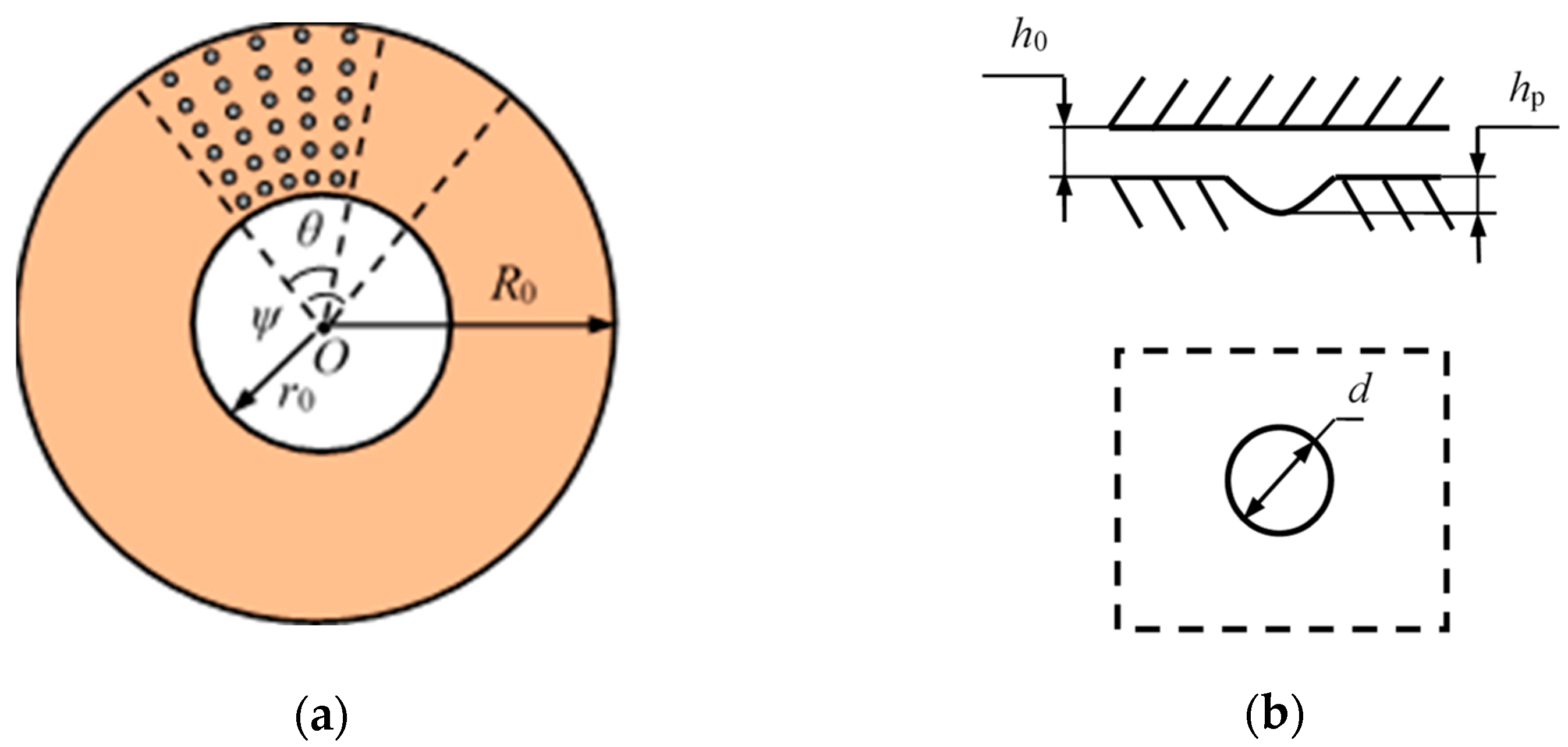


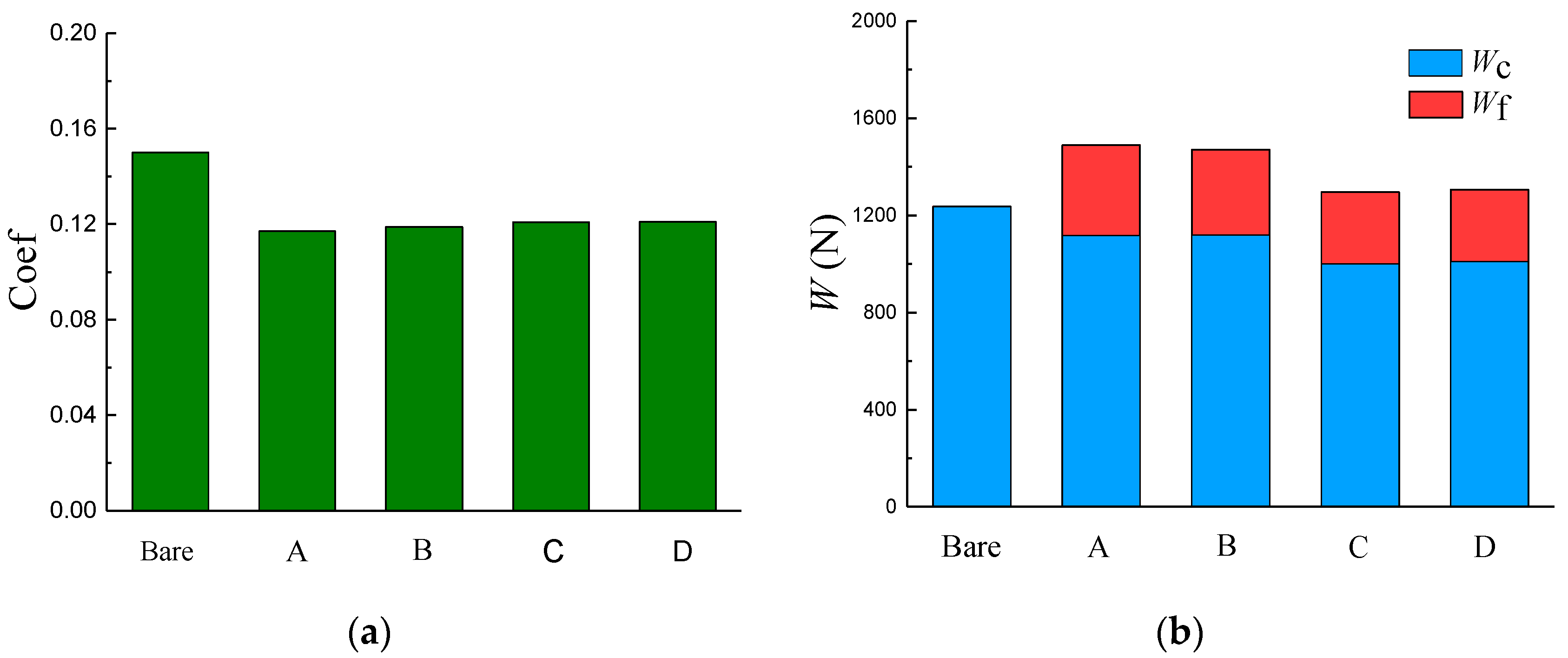
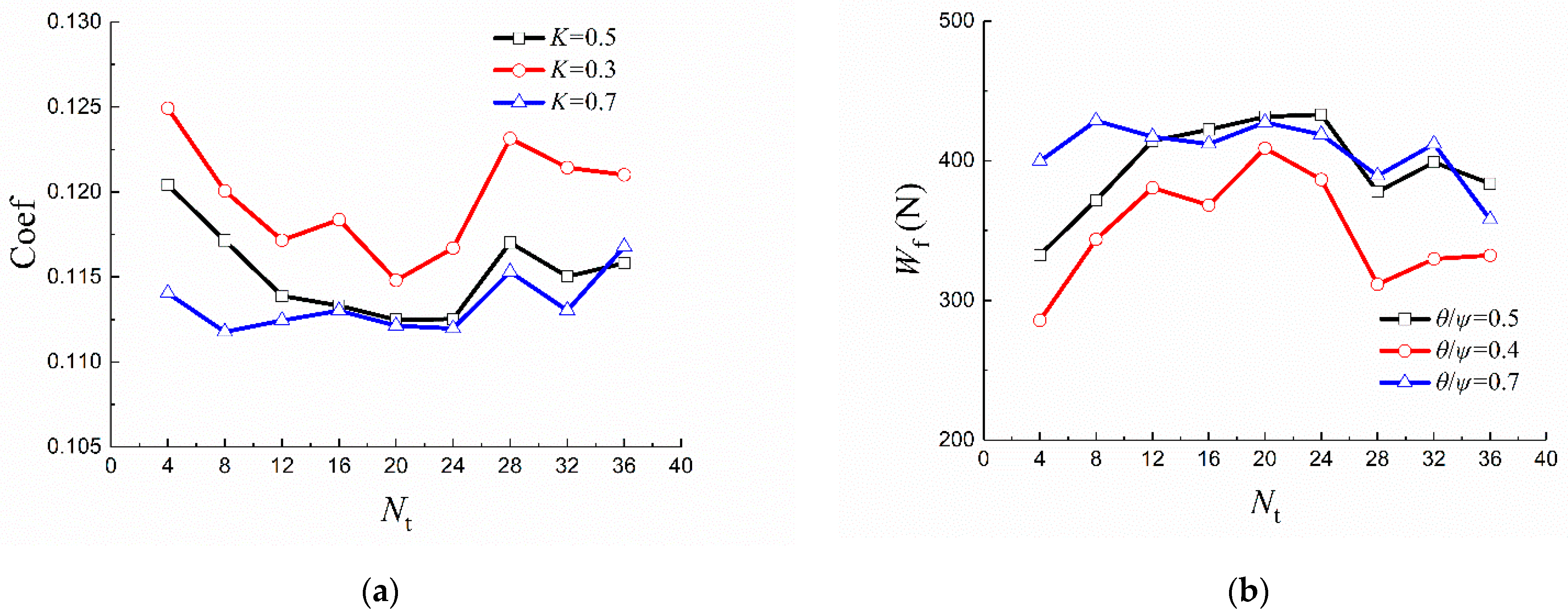
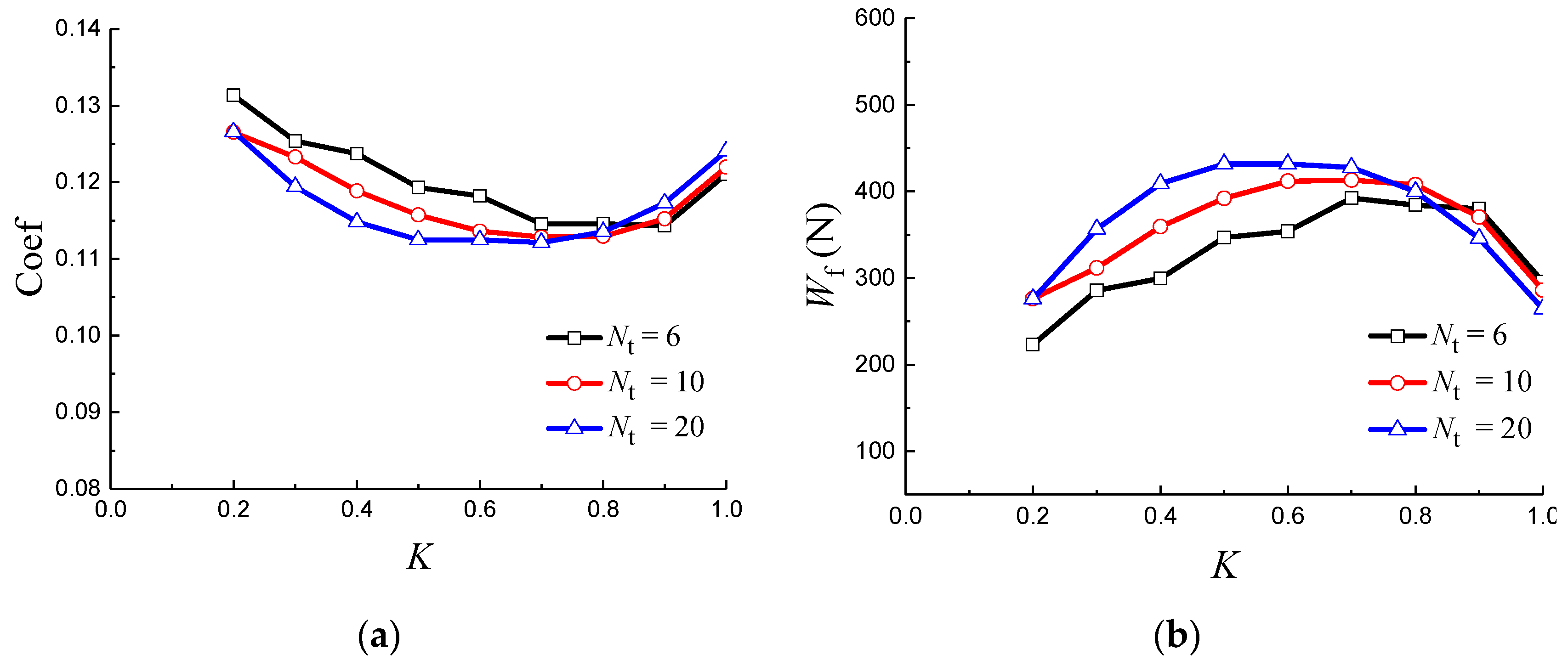
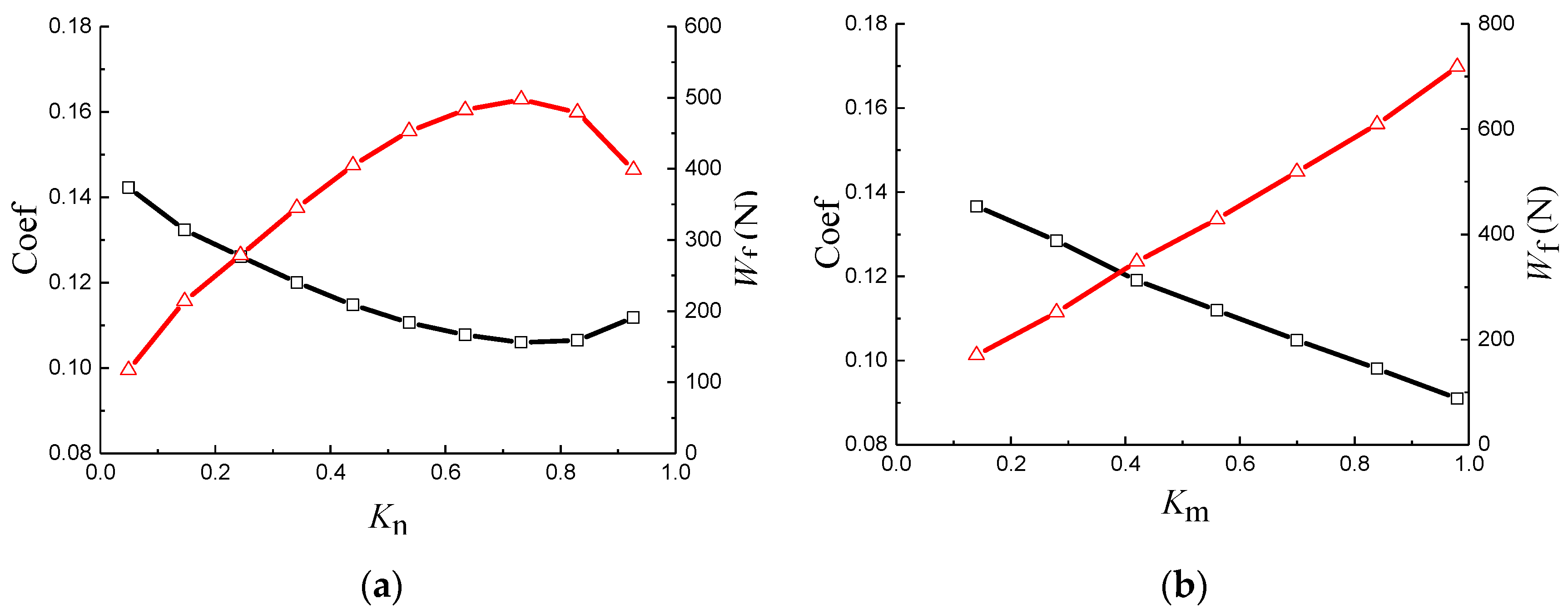

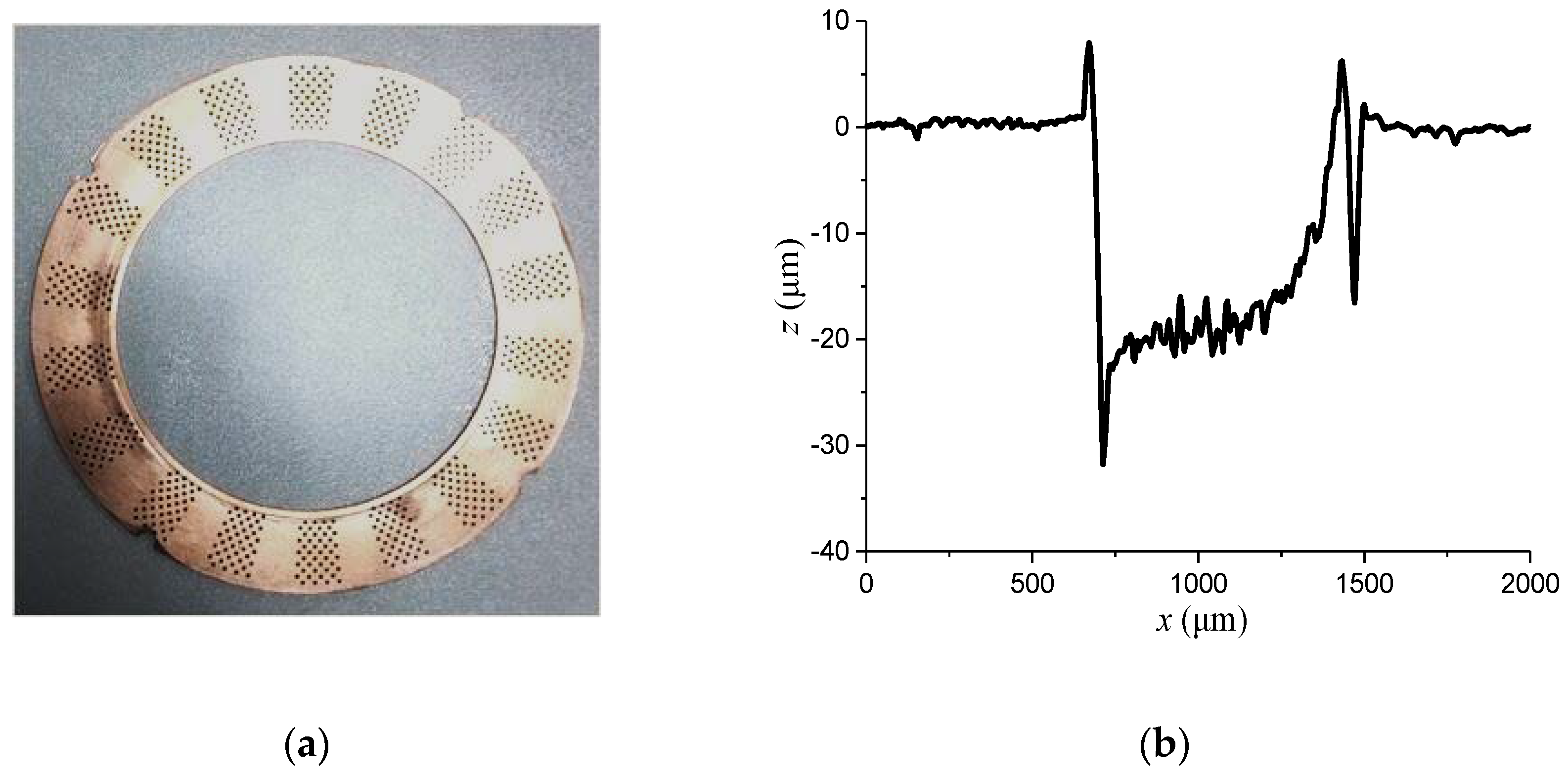


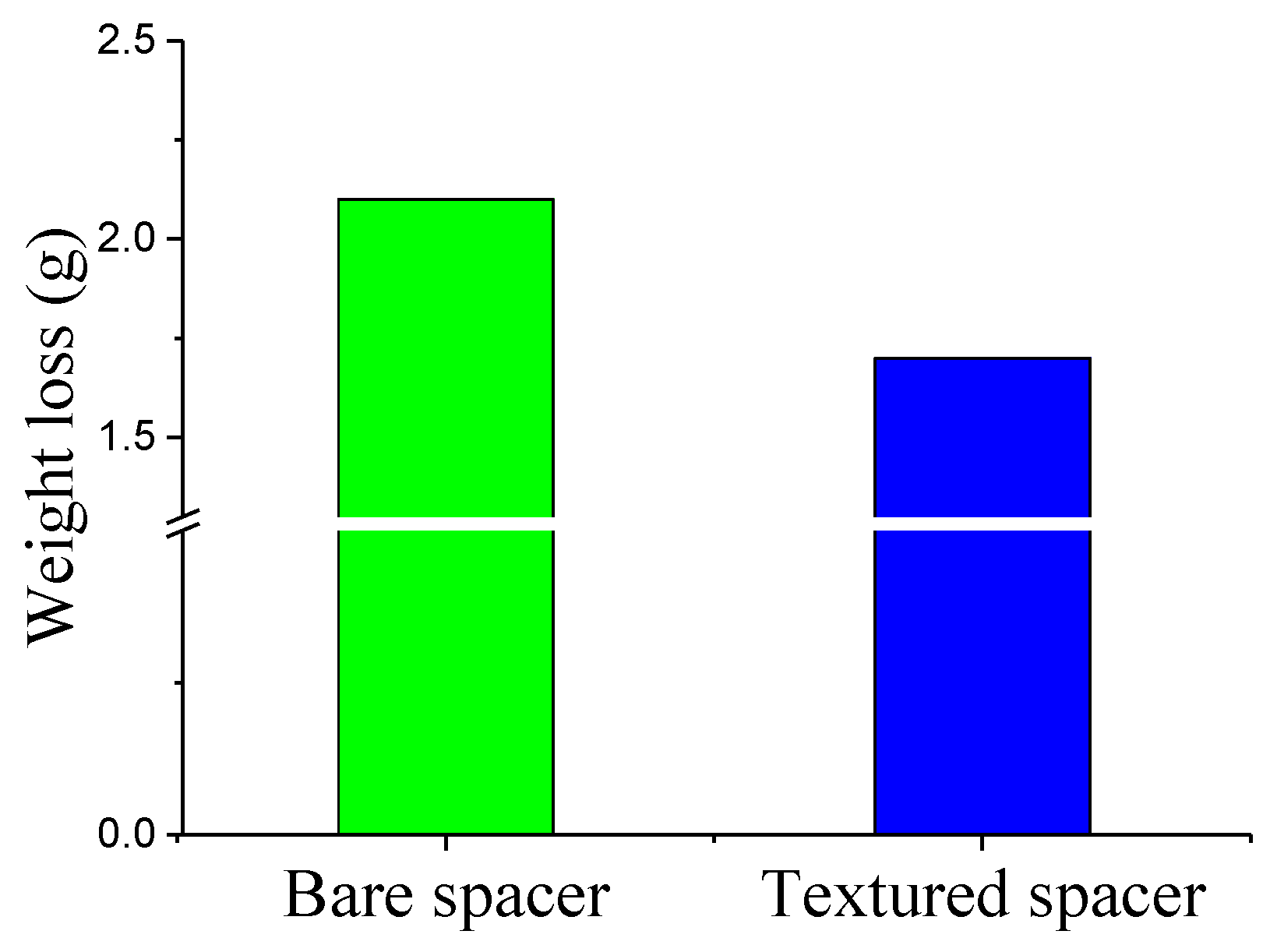
| M | 4 | 5 | 6 | 7 | 8 | 9 | |
|---|---|---|---|---|---|---|---|
| N | |||||||
| 6 | 7.2% | 9% | 10.8% | 12.6% | 14.4% | 16.2% | |
| 8 | 9.8% | 12.3% | 14.8% | 17.2% | 19.7% | 22.1% | |
| 10 | 12.5% | 15.6% | 18.7% | 21.8% | 24.9% | 28.1% | |
Publisher’s Note: MDPI stays neutral with regard to jurisdictional claims in published maps and institutional affiliations. |
© 2021 by the authors. Licensee MDPI, Basel, Switzerland. This article is an open access article distributed under the terms and conditions of the Creative Commons Attribution (CC BY) license (https://creativecommons.org/licenses/by/4.0/).
Share and Cite
Liu, Y.; Zhang, H.; Dong, G. A Design of Partial Textured Surface on Gear Washers for Reducing Friction and Wear under Low Speed and Heavy Load Conditions. Materials 2021, 14, 4666. https://doi.org/10.3390/ma14164666
Liu Y, Zhang H, Dong G. A Design of Partial Textured Surface on Gear Washers for Reducing Friction and Wear under Low Speed and Heavy Load Conditions. Materials. 2021; 14(16):4666. https://doi.org/10.3390/ma14164666
Chicago/Turabian StyleLiu, Yang, Hui Zhang, and Guangneng Dong. 2021. "A Design of Partial Textured Surface on Gear Washers for Reducing Friction and Wear under Low Speed and Heavy Load Conditions" Materials 14, no. 16: 4666. https://doi.org/10.3390/ma14164666
APA StyleLiu, Y., Zhang, H., & Dong, G. (2021). A Design of Partial Textured Surface on Gear Washers for Reducing Friction and Wear under Low Speed and Heavy Load Conditions. Materials, 14(16), 4666. https://doi.org/10.3390/ma14164666






